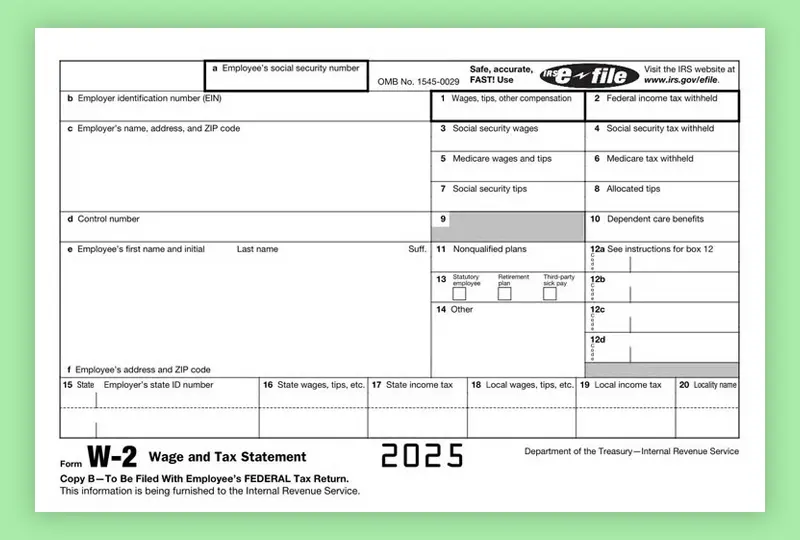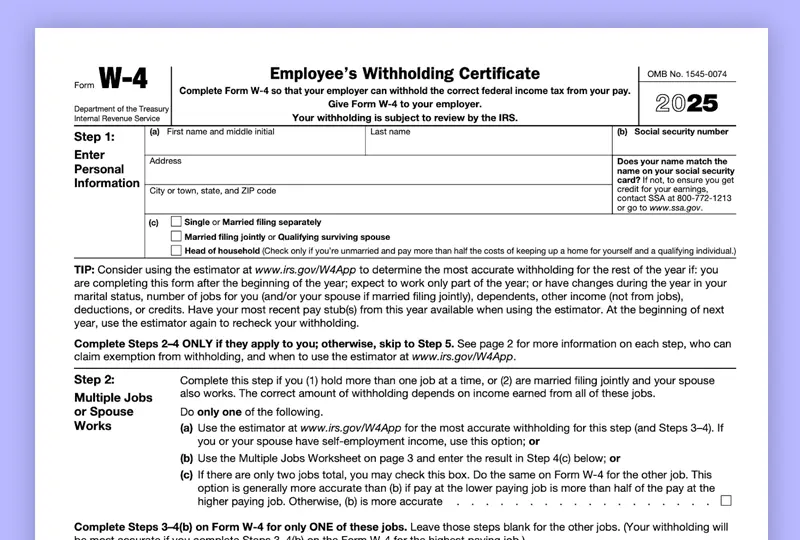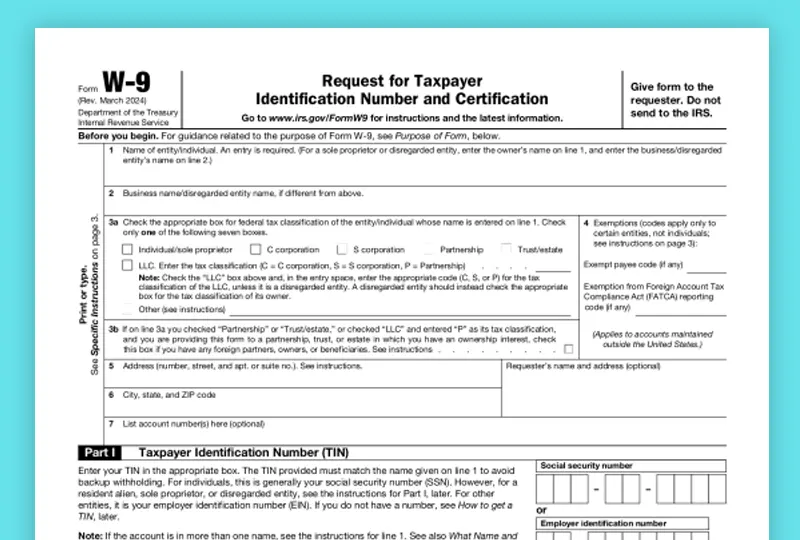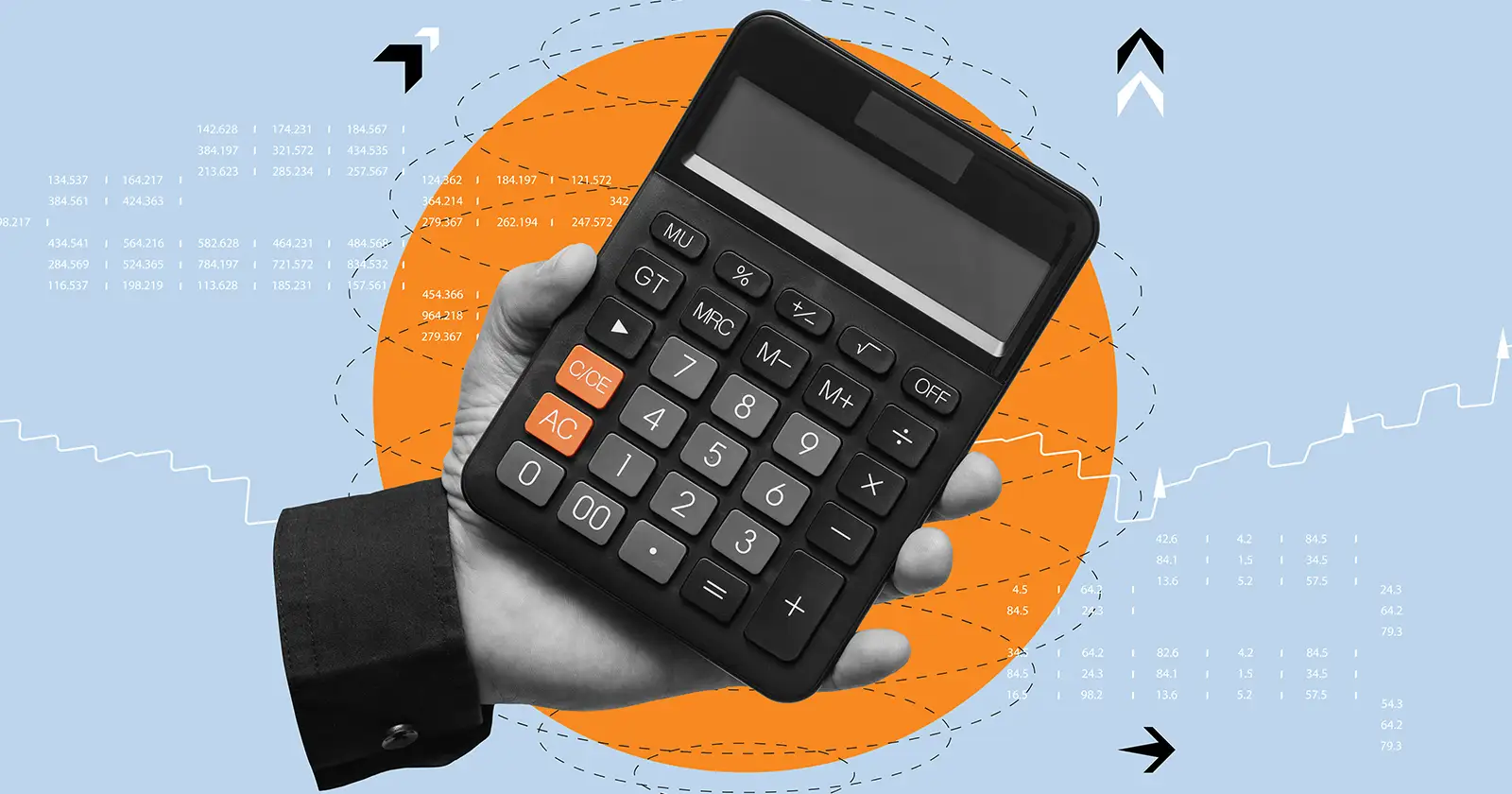Few people relish getting into the nitty-gritty of tax forms. But they’re a necessary part of working life for all of us, whether employers, employees, or independent contractors. Forms W-2, W-4, and W-9 play an important role in ensuring that everyone receives accurate payments and the right taxes are paid to local, state, and federal authorities.
But which form is required, and when? This article breaks down each form’s purpose and spotlights how modern HR software tools can streamline the management of tax forms to improve accuracy, compliance, and onboarding efficiency.
{{rich-takeaway}}
What is Form W-2?
Form W-2 is also called a Wage and Tax Statement and, like the W-4 and W-9 forms, is a US Internal Revenue Service (IRS) tax document. If you run a business and pay an employee at least $600 in a year — even in noncash compensation, such as the use of a company car — or withhold any income, Social Security, or Medicare tax from their pay, you’re required to file a W-2 for them. This applies whether or not the individual is a family member.

Who receives Form W-2?
Employees receive the form. The Social Security Administration (SSA) requires employers to send team members Form W-2 by January 31. Employees use information on the W-2 to prepare and submit their income tax returns.
“This is ultimately what employees receive at the end of the tax year that helps them file their taxes,” said Eric Mochnacz, director of operations at Red Clover, an HR consulting firm. “It makes sure that it includes all the key details and earnings that reflect to the IRS and the government, ‘Hey, I've paid all my taxes, or maybe I didn't, so then I owe the government money.’”
Employers are also required to send W-2 forms to the SSA, which matches the name and Social Security Number (SSN) on each form and records the earnings in the employee’s earnings history.
What’s included on Form W-2?
As a sample form on the IRS website shows, Form W-2 provides a full breakdown of an employee’s wages and mandatory and voluntary payroll deductions, such as federal income tax and health insurance premiums, for the tax year. That includes the total amount of:
- Wages, bonuses, and tips
- Federal income tax withheld by the employer
- Federal Insurance Contributions Act (FICA) withholding, covering deductions for Social Security and Medicare taxes
- Local and state income tax withholding, if applicable
- Other pre-tax contributions made, such as for 401(k)s or dependent care benefits
{{rich-highlight-2}}
What is Form W-4?
Form W-4, Employee’s Withholding Certificate, is an IRS form filled out by employees at the start of employment and updated as their tax situation changes, such as after they change their marital status or have a baby. This form determines how much federal income tax is withheld from each paycheck, which impacts the size of an employee’s take-home pay and year-end tax return.

Who receives Form W-4?
The employer receives a W-4 from their employee to ensure the employer withholds the correct federal income tax from their compensation. “What [the employee is] doing is they're communicating any special tax situations that need to be reflected in their paycheck,” Mochnacz said.
What’s included in Form W-4?
When completing a W-4, employees fill out the following information about themselves:
- Name, address, and SSN
- Tax filing status, such as single; married, filing separately; married, filing jointly; or head of household
- Disclosure of multiple jobs or working spouse (if applicable)
- Total number of dependents
- Other income, such as dividends or retirement income, deductions, and extra withholding
What is Form W-9?
Independent contractors and freelancers fill out Form W-9, Request for Taxpayer Identification Number and Certification, to provide clients with the necessary information for accurate payment and tax reporting.

Who receives Form W-9?
Businesses receive the W-9 form from the independent contractors or freelancers that they work with. “This is ultimately saying, ‘This is how you pay us appropriately. This is my tax ID number,’” Mochnacz said. And, for the business, he added, it’s an opportunity for them to verify that they know how to properly pay the gig worker through the company.
What’s included on Form W-9?
Independent contractors fill out the following information when completing Form W-9:
- Entity name and address
- Federal tax classification, such as sole proprietor, LLC, C corporation, or S corporation
- Taxpayer Identification Number (TIN), typically either the individual’s Social Security number or employer identification number (EIN), a nine-digit number that the IRS assigns to identify taxpayers who must file business tax returns
{{rich-highlight-1}}
Tax Compliance and Risk Management: Avoiding Worker Misclassification
When it comes to Forms W-2, W-4, and W-9, a common mistake employers make relates to worker classification. Often, to save money, employers will misclassify employees as independent contractors, said Courtney Berg, president of HR consulting firm CourtSide Consulting.
From an employer’s perspective, hiring an employee comes with additional costs, such as workers’ compensation, unemployment insurance, payroll taxes, and, in some states, mandatory paid sick leave, Berg noted. By contrast, paying an independent contractor is often seen as simpler and more cost-effective. The contractor is considered a business expense with no requirements to pay out extra benefits, insurance, or expenses.
But, Berg pointed out, deciding whether the individual is an employee or an independent contractor isn’t up to the employer. “If you're considering putting somebody on a W-9, be sure to check to see if they are really an independent contractor or if you just want them to be,” Berg said.
Some individuals also may argue that they’d rather manage their own benefits and tax liability as an independent contractor, Mochnacz said. “But I remind these small business owners that it's not up to the employee, and it’s not up to the employer. The federal government has guidelines that outline what constitutes a W-2 employee versus a 1099 contractor.”
To decide whether an individual should be classified as an employee or an independent contractor, an employer must evaluate their relationship with the individual in three categories, as spelled out in the IRS common law rules:
- Behavioral: Does the company control how and when the individual completes their work?
- Financial: Who controls how the worker is paid, reimbursed, or equipped?
- Type of relationship: Is the individual involved in work that is central to the business or receiving benefits, such as health insurance, paid time off, or a retirement plan?
Generally, an independent contractor is someone who works for a variety of clients, doesn’t receive any perks or benefits, works on their own time, and is responsible for paying all of their own taxes. Meanwhile, an employee works for just one company, receives benefits, and has taxes withheld from their paycheck via their employer.
Getting this wrong can be costly, and cases of misclassification can pop up in various ways. For example, an individual may have been working exclusively for a company as a gig worker through a multi-year contract. And, when the contract ends, after so much time, the individual may feel like they are entitled to state unemployment benefits, which are not provided to independent contractors.
But they filed for unemployment anyway, triggering questions to the company from employment regulators about whether the individual was improperly classified as a contractor. “It creates a scenario where all these different regulatory and compliance factions of the government find your company intriguing,” Mochnacz said. And that could spark an investigation or audit.
If a business is found at fault for misclassifying workers, it could be liable for FICA taxes and penalties for not properly withholding tax dollars, among other issues. “Those could add up very fast,” DeCarrera said.
3 Best Practices for Maintaining Forms W-2, W-4, and W-9
In addition to ensuring workers are properly classified as either employees or independent contractors, there are other smart practices for maintaining the forms and ensuring the organization remains in compliance.
1. Collect forms in a timely manner.
Whether hiring an employee or working with an independent contractor, the timely collection of forms is critical to ensure employers know who they are paying and how they should be paid.
For employees, that should happen during regular onboarding, Berg said. A W-4 tax form should be collected as part of the new hire paperwork on or before their first day of work.
For independent contractors, companies should request the W-9 along with the signed contract and other project-related documents at the beginning of the working relationship. If you’re only working with the freelancer on a single, quick project at the beginning of the year, it may be more difficult to collect the W-9 months later when the working relationship has ended.
2. Encourage keeping forms up-to-date.
Throughout the year, your employees navigate big life milestones. They’re moving, celebrating a marriage, or welcoming new babies into their families. Those changes may all trigger the need to update their filing status and other information on their W-4.
DeCarrera recommends encouraging workers around October and in the new year to ensure that their W-4 is up-to-date. Online portals with self-service features, such as Lattice HRIS, make this easy for employees to do on their own.
It’s never a good practice, however, for employers to make changes for employees or give them tax advice, DeCarrera said. Even with good intentions, an employer could accidentally input wrong information. Or, worse, the employee could blame their employer for giving them bad tax advice that leaves them owing more in taxes.
Independent contractors should keep their W-9s updated. A new mailing address, business name change, new EIN, or entity classification, such as changing from an LLC to an S corporation, could all trigger the need for a new W-9.
3. Use an HRIS to save time and maintain compliance.
An independent contractor might not have access to your company’s human resources information system (HRIS), but the HR solutions can help maintain compliance and documentation for employees. Self-service portals can be especially helpful when team members need to update their W-4 or access their W-2, Berg advised. It allows employees to get what they need on their own time, and it gives HR professionals the ability to work on more strategic initiatives.
Instead of hunting down employees’ W-2 forms before tax day, the HR team can spend that time working on ways to boost employee engagement or devising more strategic hiring practices. “Those things are way more powerful and impactful in an organization than copying a W-2 for an employee,” Berg said.
{{rich-highlight-6}}
⚠️ Tip: Tending to Form 1099
Information from a completed W-9, particularly the TIN, is used to prepare Form 1099-NEC, Nonemployee Compensation. The IRS uses Form 1099-NEC to monitor money paid to individuals or businesses who are associated with that TIN. Businesses are required to send the form to their vendors by no later than January 31.
Independent contractors are responsible for paying their own estimated income tax and federal self-employment taxes, which cover both the employer and employee portions of Social Security and Medicare. When filing their taxes, independent contractors use the 1099s they receive from their clients.
A 1099 is generally required when a business pays an independent contractor more than $600 in a year, but they are free to issue one even if they paid the freelancer less than that amount. “You can still send one even if you don’t pay them $600,” noted Kimberly DeCarrera, a finance and business attorney and founder of Springboard Legal, who serves as a fractional general counsel and chief financial officer for organizations.
⚠️ Tip: Keep W-2s in mind during payroll migrations.
When migrating to a new payroll system, especially mid-year, consider how W-2s will be handled, Mochnacz advised. Some payroll providers won’t take responsibility for wages they didn’t process, which means employees may receive two W-2s for the same tax year. Other vendors can import prior payroll data and produce a single W-2.
Employers should ask potential vendors up front whether they can consolidate the data into a single W-2, he recommended. Ideally, to avoid multiple W-2s or any confusion, Mochnacz suggests migrating to a new provider between December 31 and January 1.
🚩 Disclaimer: This article is for informational purposes only and does not constitute legal, tax, or compliance advice. Businesses should consult a qualified tax professional or legal advisor to ensure compliance with applicable laws and regulations.
Key Takeaways
- Form W-2 is issued by employers to employees and the SSA each January, summarizing annual wages and taxes withheld for accurate income tax filing.
- Form W-4 is completed by employees during onboarding (and updated as needed) to determine how much federal income tax their employer should withhold.
- Form W-9 is filled out by independent contractors to provide businesses with tax identification details, which are later used to generate Form 1099-NEC.
- Proper worker classification is critical: misclassifying employees as contractors can trigger IRS penalties, back taxes, and audits.



.webp)




